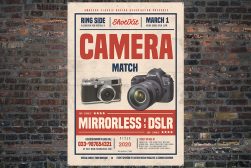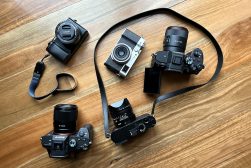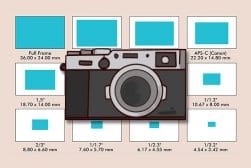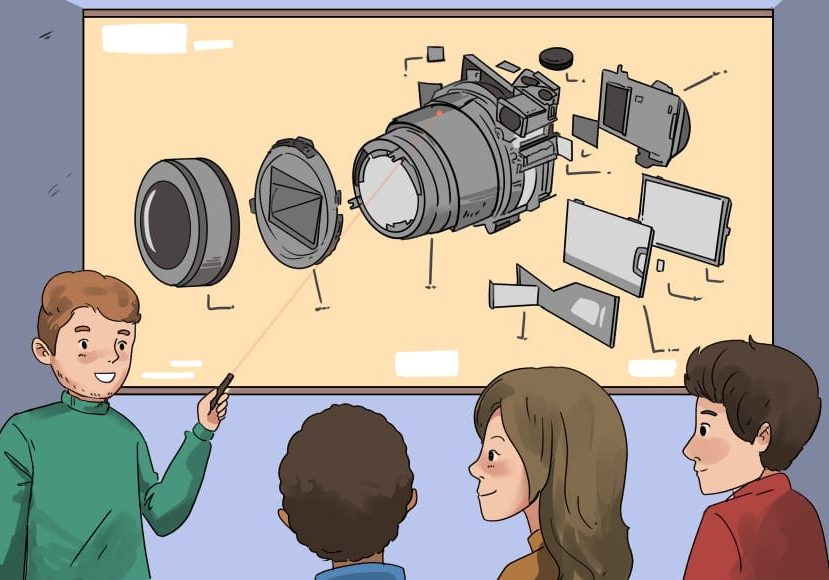
Learn The Parts Of A Camera
This simple and easy-to-follow guide explains the parts of a digital camera and how they work together. Learn the photography basics!
Learn | Photography Guides | By Stephan Jukic
Shotkit may earn a commission on affiliate links. Learn more.
Do you know all the main parts of your digital camera and how they work together?
You’d think this would be one of the most basic things to learn when getting into photography. Amusingly, though, some people manage to take great pictures without ever learning these details.
This doesn’t mean that it’s not important to know all the main parts of a camera, but I’d bet that not knowing is a lot more common than it might seem, even among photographers.
So that’s what we’re going to cover right now with this simple, handy guide. We’ll take you through the dozen or so key parts of camera technology, and clearly explain how they work together to let you capture stunning images.
This guide focuses on the key parts of today’s digital DSLR and mirrorless cameras, and not analog film cameras, which work differently in certain ways.
Photo Capture: Essential Camera Parts

Camera parts diagram
The following are the most essential internal and external parts of a camera for the actual process of creating photos.
Camera Body
The body of your digital mirrorless or DSLR camera is what contains the essence of the device.
What the camera body does not include is the lens, external flash, or any other removable interchangeable parts. Cameras without a built-in lens are called interchangeable lens cameras. Another kind are fixed lens camera models, which have an integrated lens that can’t be removed or changed.
DSLR cameras tend to have bulkier bodies while mirrorless cameras usually come with more compact builds.
The reason why is that DSLR editions need to make space for an internal mirror that reflects light from the lens to their optical viewfinder. Mirrorless cameras don’t need this mirror.
This is the main difference between the two camera types and the reason why mirrorless cameras have their name.
Aside from this, DSLR and mirrorless cameras are nearly the same in the basic build and functionality of their parts.
It’s also worth noting that some cameras come with fully weather-sealed bodies and lens mounts (with weather-sealed lenses available too) so you can face rainy, wet or dusty conditions without worrying too much about mechanical failure.
On a final note, when you’re buying a new digital camera, remember that some interchangeable lens models are sold body only, meaning that you’ll have to buy a lens separately.
Image sensor and processing engine
This is perhaps the most important part of the camera anatomy.
When you take a photo, external light enters through your lens aperture (i.e, its opening) and hits the image sensor. This image sensor then captures the light and converts it into a digital recreation of the scene.
In both mirrorless and DSLR cameras, the sensor is covered in a vast array of pixels which absorb light and convert it to electrical signals of differing intensity (depending on how much light hits them). These are then sent to the camera’s image processing engine.
The processing engine converts these signals to the digital images in different colors or monochromatic tones that you eventually see with your own eyes.
Basically, the sensor, processing engine and memory combo inside any digital camera do what film does in analog cameras. The difference is that with film, the sensor and image storage are combined into a single physical, chemical-coated substance that captures an image from the light that hits it and stores it right there in the same medium.
How Much Do You REALLY Know About Photography?! 🤔
Test your photography knowledge with this quick quiz!
See how much you really know about photography...

Camera sensors come in many different resolutions. So for example, if you have a mirrorless or DSLR camera with a 24-megapixel sensor, this means it offers roughly 24,000,000 individual light-sensitive pixels that encode an image as tiny electrical signals that your camera’s processing engine converts to a 24-megapixel visual image.
Sensors also come in different types. Higher-end digital cameras tend to offer full-frame sensors that offer the digital size equivalent of a full 35mm film frame in an analog camera. Some cameras on the other hand offer cropped, smaller sensors in formats like APS-C, which mean narrower viewing angles at a certain distance.
Shutter
The shutter is crucial to making the image sensor and processing engine inside a digital camera work. This little mechanism sits inside the camera between the lens mount and sensor, and controls the duration of light that enters.
When you press the shutter release button on your camera to take a picture, it opens up the shutter for a certain length of time and allows light passing through a lens aperture (more on that below) to hit the sensor so that it can be recorded into an image.
Without pressing the shutter button, the camera’s shutter stays closed otherwise.
Camera shutter speed can range from a “Bulb” setting, which lets you keep the shutter open for multiple seconds, minutes or even hours (ever seen those photos of swirling stars at night or streaks of light from cars on a road? Well this is how they’re captured!), to much faster settings of 1/30, 1/60 and all the way up to 1/8000 of a second or more for most DSLR and mirrorless cameras.
Low shutter speeds are useful for taking longer photo exposures in darker settings (the shutter is open longer, thus letting in more light).
With higher shutter speeds, the opposite is the case: the shutter opens and closes very quickly, so a lot of light has to enter in that short space of time. That means you need to be in a brighter setting to capture a clear image of a fleeting moment in time.
While all cameras come with mechanical shutters, some models also have electronic shutters for even faster performance. These avoid mechanical “slowness” by turning the sensor on and off quickly instead of using the physical shutter to control light exposure.
They’re useful for photographers who want even faster frame rates or for taking pictures in complete silence (such as for close-up wildlife photography or street photos).
ISO
While shutter speed and sensor size are crucial for how well a camera can take photos in low light, the ISO of a digital camera is extremely important too, even though it’s not one of the physical parts of a camera.
High ISO capability means better low light performance. In other words, it’s a measure of how sensitive that camera’s sensor is to light. The better a camera’s low light performance, the higher the ISO it can use effectively.
Cameras with weaker ISO tend to create grainy images with lots of noise in lower light. Good ISO quality means a minimization of this noise even in dark conditions.
Autofocus system
The autofocus system inside a camera lets you smoothly and quickly take photos that automatically focus in on specific moving or still objects.
Some of the best cameras in existence today have hundreds of phase detection and contrast detection autofocus points on their sensor, and can use them in fractions of a second for devastatingly sharp images of even fast-moving targets.
Most DSLR and mirrorless cameras offer both single shot and continuous autofocus, as well as completely manual focus and other modes.
In any case, the basic function of autofocus technology means on-the-fly image sharpness without too much manual fiddling during shooting.
Lens
The single most important attachable part of any camera is its lens. This is what captures light from external scenes and directs it into the camera’s sensor where it interacts with all of the internal camera parts we’ve described above.
We could go into a whole other guide about camera lens types and their uses, but here we’ll keep things simple.
Most semi-pro and professional cameras are interchangeable lens models that let you attach a whole range of lens types to them as needed.
Most camera brands also offer their own proprietary lens mounts for their different camera types, and selections of zoom, prime, wide angle and other types of lenses for these mounts.
Some camera brands also offer different mount types between their mirrorless and DSLR cameras. This is important because simply having a camera from a certain brand doesn’t always mean you can just attach any lens from that same brand to the camera without an adapter ring.
On the lens, you can attach filters, lens hoods and other accessories.
Lens aperture
Lenses don’t simply pass light to the sensor inside your digital camera. They also come with an adjustable diaphragm that controls the amount of light that enters. This crucial process is called aperture.
Aperture is measured in what are called f-stops. A smaller f-stop like f/1.4 means a larger aperture and a much shallower depth of field (meaning that the camera focuses on a specific thing that’s close while the background is blurry).
A larger f-stop like f/32 means a much smaller aperture (which reduces the amount of light entering), and a longer depth of field (more of the scene is in focus).
Aperture also needs to change depending on shutter speed, since a faster shutter speed usually requires more light to enter the sensor quickly.
Control dials and buttons
The outermost parts of a digital camera body are its control dials and buttons.
These can vary from one camera to another but the basics that most digital mirrorless and DSLR cameras will have include a shutter release button, a power button, a dial for different exposure compensation levels and dials for adjusting ISO and shutter speed.
Some cameras offer more of their controls through their built-in LCD screen menu, though I think that a camera with more physical control dials is a better choice for quick adjustments.
Viewfinder and LCD screen
DSLR cameras come with optical viewfinders and mirrorless cameras with electronic viewfinders. Which of these two types is better depends on what kind of photography you’re into, so it’s hard to claim a preference.
The optical viewfinder on a DSLR shows an image that’s reflected directly from the lens without digital intervention.
An electronic viewfinder on the other hand gives you a digital live image right from the sensor, which shows you exactly what the camera is seeing.
The LCD screen has become almost universal in all modern cameras. It serves three basic functions: controlling basic camera functions through digital menus, composing images before shooting if you’re not using the viewfinder and thirdly, viewing photos after you’ve taken them.
Many LCD screens on newer cameras also come with touch functionality for controlling focus points or adjusting camera settings.
Since most LCD screens are rather small, many videographers attach external camera screen field monitors in order to get a better representation of what their camera is recording.
Memory card slot and connectivity ports
Moving onto the last of the last parts of the camera, we have the memory card slot and docking ports. Today’s digital cameras use both to store and transfer photos and video to a computer or other device.
There are also cameras with dual memory card slots on the market. This is a useful feature but not extremely important, since you can always buy larger SD memory cards for single-slot cameras.
Also, I’d recommend picking cards with high write speeds.
Having your camera freeze up because it’s trying to take photos faster than the memory card can write really messes with your shooting flow.
Accessory Camera Parts
Now that you know the camera parts and functions, the following are some additional external parts of a camera. They can be important (or not) depending on what kind of photography you’re doing.
External Flash and Hot Shoe
Many digital cameras come with their own built-in pop-up flash, but some photographers never even bother to use it. For almost all of my own photography, I barely use it, but if you’re doing fashion or party shots in low light, flash can be extremely useful.
Professional photographers in genres like fashion, commercial and portraiture, on the other hand, often do use flash but rely on an external, attachable unit for better light control.
This external flash is attached to the top of a camera with a metal electronic connection brace that’s called a hot shoe. Not all digital cameras come with one but it’s extremely useful for connecting an external flash or even other devices like a viewfinder.
Tripod Mount
Last of all, we have the tripod mount on a digital camera. Most cameras come with one of these and it’s basically a small threaded metal female connector for the male screw on a tripod.
You might never need to use a tripod for many types of photography, but if you’re doing long exposure landscape shooting or video recording it’s definitely useful.
Camera Parts | Final Thoughts
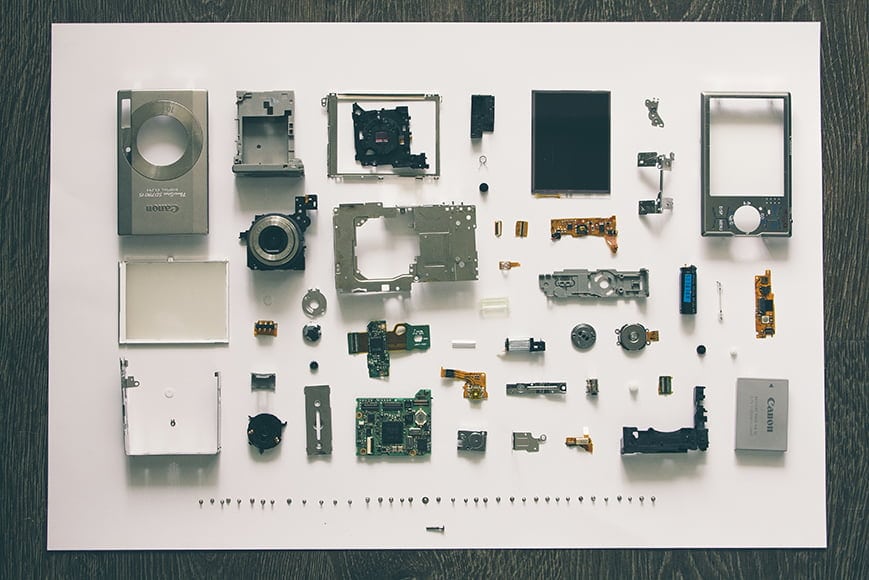
While there’s no one single most important part to a camera, the lens, shutter, sensor and processing engine make up the absolute core of photographic functionality.
If you can learn how these components work and interact while you’re taking photos, you’ll be well on the road to really understanding your own camera.
Learning to use additional parts like the flash, all the buttons and LCD menu controls is also important, but not absolutely necessary for the basics.
Hope you found this guide to the essential camera parts useful. If there’s anything we’ve left out or that you’d like covered, let us know in the comments!

Check out these 8 essential tools to help you succeed as a professional photographer.
Includes limited-time discounts.





